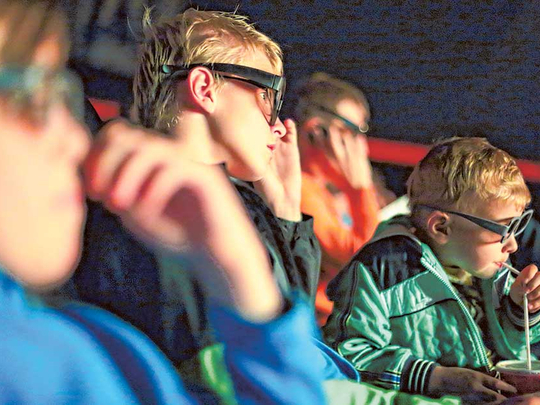
Stan Meyers has two conditions for going to a movie: It has to be in an IMAX theatre, and he has to be able to reserve a seat in the top two rows.
“The ideal seats are higher than you would think, because the screen is so tall,” he explained. “If they aren’t available, I just don’t go.”
Meyers, who analyses movie-theatre companies for Piper Jaffray & Co., knows better than most how increasingly easy it is to reserve a seat at the cinema. The rest of us will find out soon enough. All the major movie theatre companies in the US are steadily adding seat reservations across their tens of thousands of screens, in a bid to lure people away from increasingly impressive televisions and the vast, expanding universe of streaming video.
“It’s a tough game, and they’re experimenting,” Meyers said. “In five years, I would expect 50 per cent of all screens to have reserved seating.”
Atom Tickets, a start-up that sells tickets and concessions via app, said 20 per cent of its 2,000 theatre partners now offer seat booking. “We try to make everyone feel like a VIP, and reserved seating is definitely a part of that,” said Atom co-founder Matthew Bakal.
The most aggressive adopter to date is AMC Entertainment; people can call dibs on seats at almost one-third of its 400 or so US theatres. The company has added reservations to all eight of its Manhattan locations, and it expects the option to be a prerequisite for all of its theatres “in the medium-term future”.
Cineplex, meanwhile, says 14 per cent of the seats in its 164 theatres in Canada can now be booked in advance. Cinemark, which has about 513 theatres, says about one quarter of its capacity will be bookable by the end of the year.
To anyone who’s ever attended a sporting event or boarded an aeroplane, reserved seating in theatres will seem about as vanguard as the VCR. After all, seat assignments have long been standard in theatres in Europe and China. But there are valid reasons US cinema executives have long eschewed seat-booking: It’s somewhat expensive, and it’s tough to model.
If moviegoers don’t have to arrive early to snag decent seats, theatres may struggle to sell on-screen advertising slots before the show. While ticket sales and concessions make up the bulk of the movie business, nearly 6 per cent of revenue at both AMC and Regal last year came from on-screen ads and such peripheral moneymakers as arcade games.
Switching to reserved seating may also make it harder to sell out shows: If customers see that the only seats left are those in the front row, they may put off buying tickets to a show they otherwise would see.
There are also some added costs. Some reservation software is involved, and seating configurations generally vary by theatre, so the technology must be customised by location.
Then there’s the potential headache of refereeing disputes between people who reserve seats online and those who prefer to buy tickets early and hunker down in the best spots. Viewers who don’t reserve seats can typically still choose spots the old-fashioned way, as long as they’re not reserved. With moviegoing masses used to a first-come, first-claimed model, mitigating this friction could take a while.
AMC now has a thorough “education” campaign, including signs and ushers assigned to show customers to their seats. “We’ve gotten much better on how to address this from a staffing perspective,” spokesman Ryan Noonan said. Those costs are expected to subside once the moviegoing masses are used to seat assignments.
Cineplex, meanwhile, is passing on part of the expense. In its traditional cinemas, only two rows of seats can be reserved, each at an additional cost of $2. “We don’t have a one-size-fits-all philosophy for anything that we do and that also applies here as well,” spokeswoman Sarah Van Lange said.
Those are all relatively small issues. In truth, theatre owners have been slow to embrace reservations largely because they haven’t had to.
Movie attendance in the US and Canada has been largely static for a decade, at about 1.35 billion tickets a year — even with the so-called golden age of television and a preponderance of films on streaming platforms. Box office revenue has steadily risen as growth in high-definition technology inflated average ticket prices. Last year, 38 per cent of the country’s almost 44,000 screens could handle digital 3D, a format that generally commands a premium at the box office.
As a result, 2015 was Hollywood’s biggest revenue year on record.
So why are theatres all of a sudden hustling to let people pick their seats?
Young adults, for one, are staying home. From 2010 to 2015, Americans aged 18 to 39 bought 16 per cent fewer movie tickets. These are the people most likely to be building careers and raising children; they have better ways to spend 45 minutes than standing in line at the local megaplex. Babysitters don’t come cheap, and HBO’s “Game of Thrones” is now à la carte, at $15 a month.
“Competition from TV is very, very real,” said Ben Mogil, a media analyst at Stifel Nicolaus & Co. “Lots of people just don’t go to the movies at all anymore.”
Being able to show up promptly at showtime could keep some of these customers going to the movies, according to Mogil, and possibly lure others who never went at all.
Another major case for seat reservations: Hollywood’s increasing reliance on the blockbuster. Studios and cinemas are making a greater share of their money from a smaller selection of films these days. In 2014, the top 10 films accounted for 26 per cent of box office revenue; this year, those films are raking in 39 per cent of ticket sales, according to Bloomberg Intelligence.
What’s more, these movies are burning out at the box office more quickly, as the number of days it takes a movie to earn 90 per cent of its total box office haul keeps shrinking. For top films, that figure stands at about 30 days, down from about 40 days two years ago, according to Stifel Nicolaus.
In short, theatre companies need to get more people in the doors more rapidly. Seat reservations have proven particularly useful at doing just that by spreading crowds through the day. When consumers see a crowded theatre with the best seats spoken for, they are more likely to buy tickets for a screen time they would not otherwise have embraced.
Regal Entertainment, the country’s largest theatre owner, has been adding seat selection to many of its busier, urban locations. “Where we see a demand for reserve seating, we’re sure going to offer it,” CEO Amy Miles said on a recent conference call.
Reservations are just part of a major overhaul of the US movie business. Theatre owners are swapping small seats out for big recliners, switching standard screens out for IMAX and 3D, and adding fancier (read: more profitable) food. “Moviegoing used to be a generic experience. Now the focus is to reverse that and turn it into an enhanced experience,” Meyers said.
AMC is systematically tearing out about half its seats, theatre by theatre, and seeing big net-attendance increases as a result, according to Noonan. Less really is more, in this case. In the business, this is called “reseating,” and most major players are doing it. “It comes down to the industry becoming more guest-friendly,” Noonan said.












